Filipino markets create bonding moments by bringing people together through shared food experiences, cultural traditions, and community connections. When you gather with loved ones, the aroma of local dishes like lechon and bibingka enhances warmth and connection. Storytelling and family values play an essential role in shaping your purchasing decisions, reflecting your priorities. These interactions foster a sense of belonging, making every visit memorable. Explore how these elements intertwine to strengthen relationships even more.
Key Takeaways
- Food plays a central role in Filipino markets, fostering warmth and connection among community members during gatherings and events.
- Kamayan-style dining encourages sharing, enhancing sensory experiences and embodying the spirit of bayanihan through communal plates.
- Emotional storytelling in market experiences resonates with consumers, creating connections that go beyond simple transactions.
- Social media platforms facilitate engagement and community building, strengthening bonds among consumers and local businesses.
- Non-verbal communication, such as smiles and physical contact, enhances relationships in markets, promoting affection and rapport among participants.
The Role of Food in Filipino Gatherings

When you gather with family and friends in the Philippines, food takes center stage, creating an atmosphere of warmth and connection. Traditional dishes like lechon and bibingka shine during festive occasions, reflecting the rich cultural heritage you share.
Meals are often enjoyed kamayan-style, using your hands, which deepens the sensory experience and fosters closeness. Rice, a staple at every meal, symbolizes hospitality and completeness.
Sharing food from communal plates strengthens social bonds, embodying the spirit of bayanihan. As you serve elders first, you show respect for their wisdom.
Whether it’s a festive Noche Buena or a simple family dinner, the dining table becomes a hub for stories and laughter, creating lasting memories that connect generations.
Community-Driven Events: Strengthening Bonds
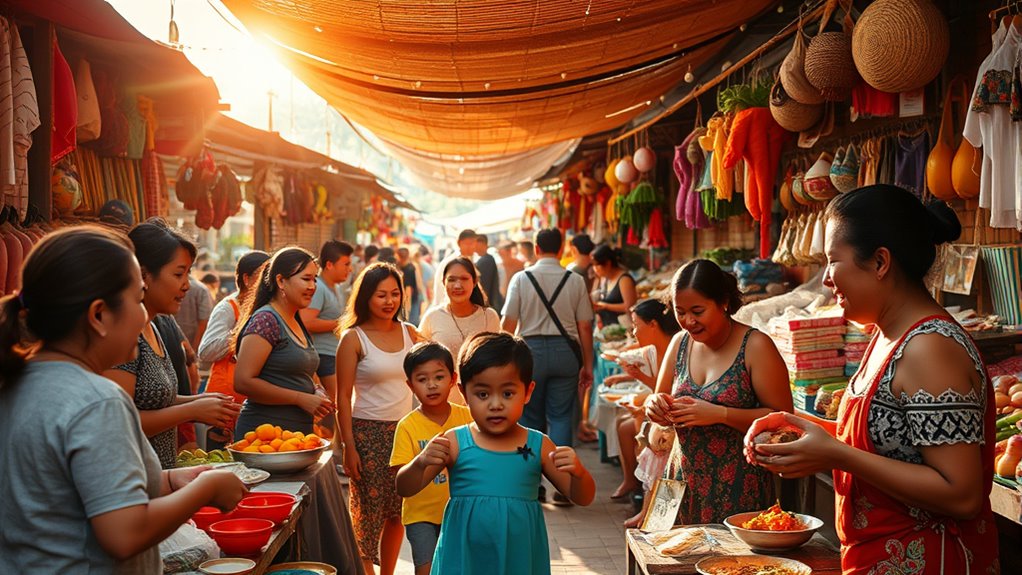
Food not only brings people together but also sets the stage for community-driven events that strengthen bonds among Filipinos.
These events often incorporate local themes and cultural elements, making them relatable and engaging. By encouraging community participation through interactive activities and workshops, you foster deeper connections with your neighbors.
Partnering with local businesses not only supports the economy but also builds stronger ties within the community. Customized event spaces reflecting Filipino culture enhance authenticity, while an inclusive atmosphere welcomes diverse attendees.
Collaborating with local businesses fosters economic growth and strengthens community bonds, creating authentic spaces that embrace diversity and Filipino culture.
Networking opportunities arise across various industries, promoting collaboration. With cultural performances and local talent showcases, these events enrich your experience and instill community pride, ensuring that everyone feels valued and connected. Additionally, embracing the journey to parenthood together can create a shared experience that further deepens these community bonds.
Emotional Storytelling in Market Experiences
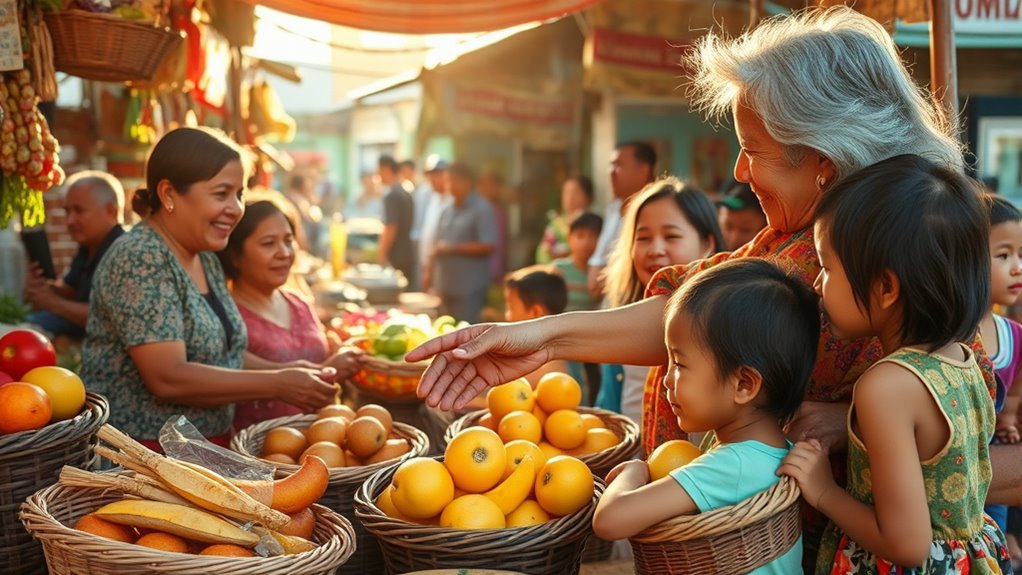
Emotional storytelling in market experiences captivates consumers by forging connections that go beyond mere transactions. When you encounter relatable narratives, it resonates deeply, enhancing your loyalty and engagement with brands.
Incorporating local myths and cultural themes makes these stories uniquely Filipino, drawing you in even further. Effective market research helps brands understand what matters to you, tailoring stories that align with your values.
Collaborating with local influencers can amplify these narratives, ensuring they reach a wider audience. Plus, platforms like Facebook make stories accessible, allowing you to engage with content effortlessly.
Family Values in Purchasing Decisions
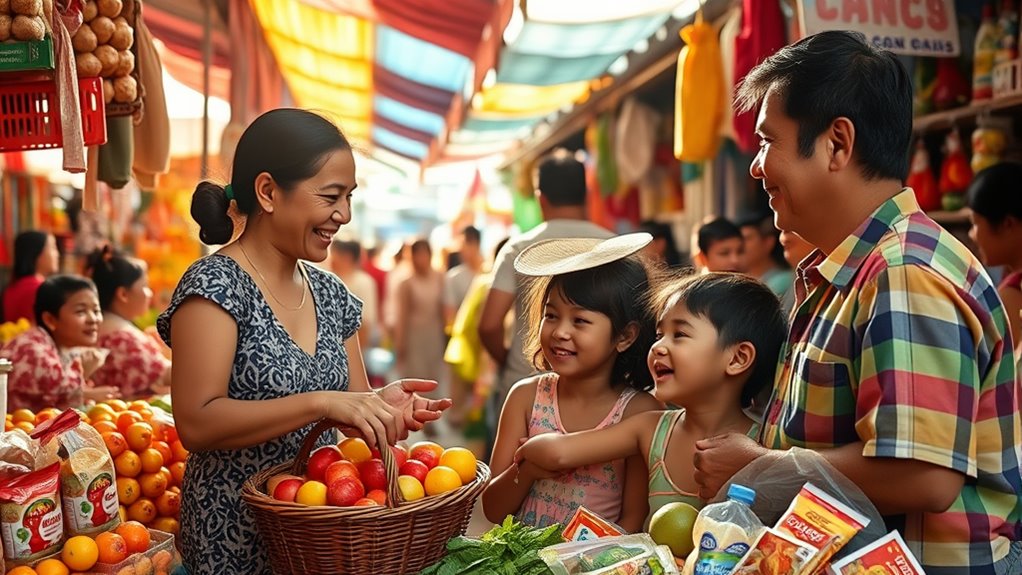
Family values play a pivotal role in shaping your purchasing decisions in the Filipino market. When you shop, you often gather input from family members, with parents taking the lead in deciding what to buy.
You prioritize the needs and preferences of your loved ones over your own desires. Family-sized products are especially popular, reflecting a shared utility that resonates with your values.
Economic conditions also play a part; you seek affordable yet high-quality items, especially during the festive season when spending can exceed monthly incomes. Supporting local businesses is important too, as it strengthens the community.
Ultimately, family-driven choices foster deep connections and shared experiences that enhance your market interactions.
Celebrating Cultural Traditions at Markets

As you wander through the bustling markets of the Philippines, you’ll discover a vibrant tapestry of cultural traditions celebrated through food and community gatherings.
Each market showcases diverse culinary delights, influenced by Malay, Chinese, Spanish, and American cultures. You’ll find traditional dishes like *lechon* and *bibingka*, especially during festivals such as *Noche Buena*, bringing families together.
Street food vendors serve affordable meals, creating opportunities for social interaction. Markets buzz with festivals that highlight local ingredients, crafts, and performances, fostering a sense of community.
You’ll witness how cultural practices are passed down through generations, as traditional garments and crafts blend with modern goods.
It’s a lively celebration, where every bite and moment strengthens your connection to Filipino heritage.
Social Media’s Impact on Market Engagement
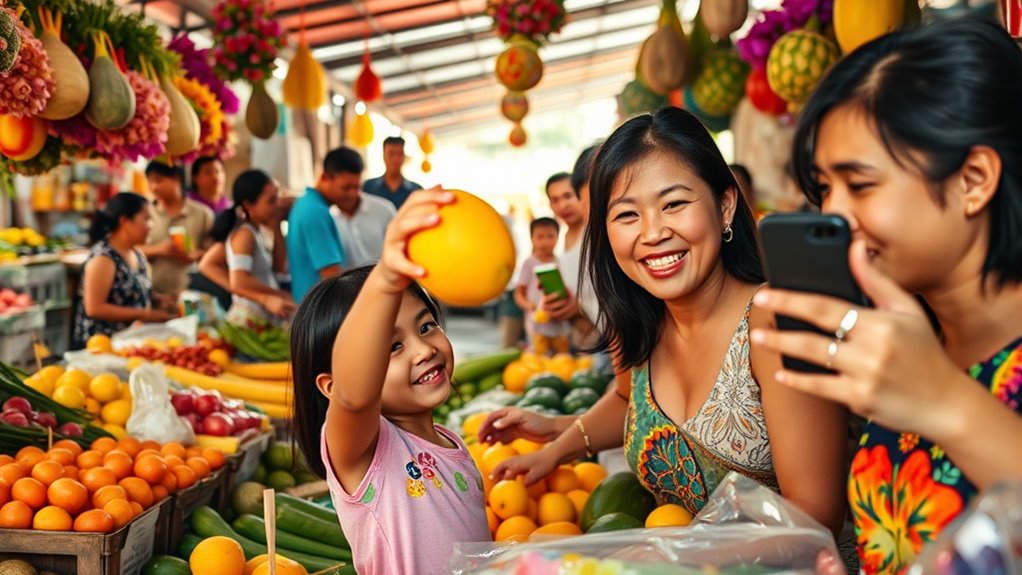
Markets in the Philippines not only celebrate cultural traditions but also serve as dynamic platforms for social media engagement. With one of the highest social media penetration rates globally, you’ll find platforms like Facebook and Instagram buzzing with activity.
The tech-savvy youth frequently use these channels, seamlessly integrating social media into their daily lives for everything from news to commerce. This digital landscape influences consumer behavior, enhancing brand perception and driving purchase intent through engaging content.
As you explore local markets, you’ll notice how businesses leverage social media for targeted advertising and community building, fostering loyalty among consumers. Social media isn’t just a tool; it’s an essential part of how you connect with markets and brands.
The Influence of Local Influencers

While you navigate the vibrant landscape of Filipino markets, you’ll quickly notice the significant role local influencers play in shaping consumer behavior. With 70% of online shoppers making purchases based on their recommendations, these influencers foster trust through their authenticity and relatability.
They effectively leverage platforms like TikTok and YouTube to connect, often simplifying the marketing process from awareness to conversion. As you engage with these influencers, you’ll find their endorsements serve as valuable social proof, validating your choices.
Their deep understanding of Filipino cultural values—like community and social connections—enhances credibility, making you more likely to trust their suggestions. Ultimately, local influencers not only drive sales but also create a sense of community, enriching your market experience. Additionally, their ability to experiment with unique twists in their content keeps audiences engaged and eager for more.
Food as a Love Language in Filipino Culture
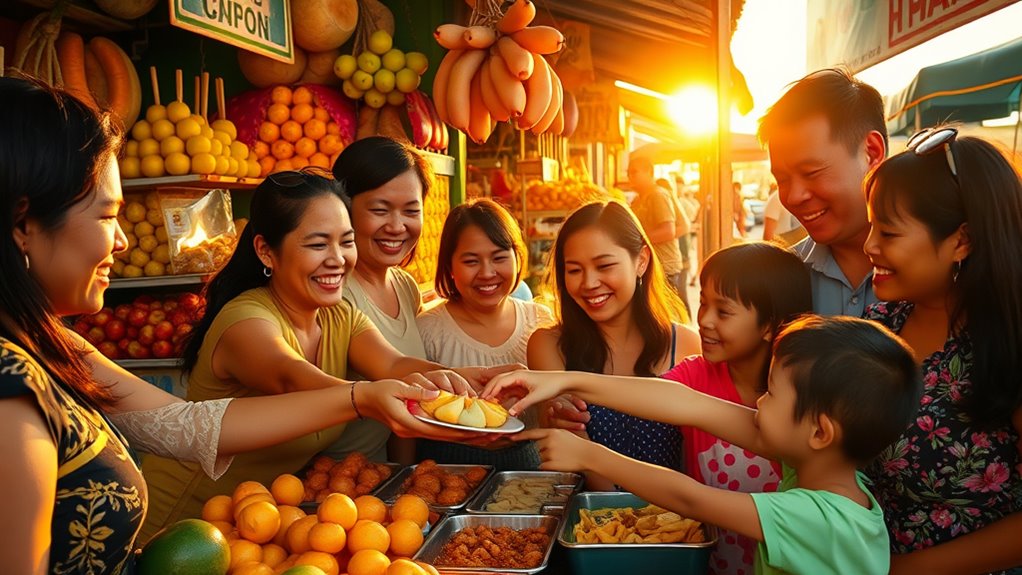
Local influencers might shape your shopping habits, but when it comes to deepening connections, nothing speaks to the heart quite like food in Filipino culture.
The warm hospitality of Filipinos shines through when they greet you with a spread of traditional dishes, symbolizing love and community. At family reunions and fiestas, sharing meals becomes a central activity, strengthening bonds among family and friends. The culinary creations showcased in these gatherings highlight not only the flavors but also the artistry behind each dish. Additionally, the act of sharing food promotes wellness topics that emphasize the importance of community in fostering overall health. For instance, the concept of bread pudding, which transforms stale bread into a comforting dessert, mirrors how Filipino cuisine often creatively repurposes ingredients to minimize waste and maximize enjoyment.
Dishes like adobo, lechon, and lumpia evoke nostalgia, reminding you of cherished memories. Each bite connects you to your heritage, showcasing the rich blend of diverse influences. Moreover, the joy of cooking and sharing meals embodies the essence of global flavors, bringing people together in a celebration of culinary traditions.
In every gathering, food isn’t just sustenance; it’s an expression of generosity and warmth, fostering a sense of belonging that resonates deeply within Filipino hearts.
Non-Verbal Communication in Social Interactions
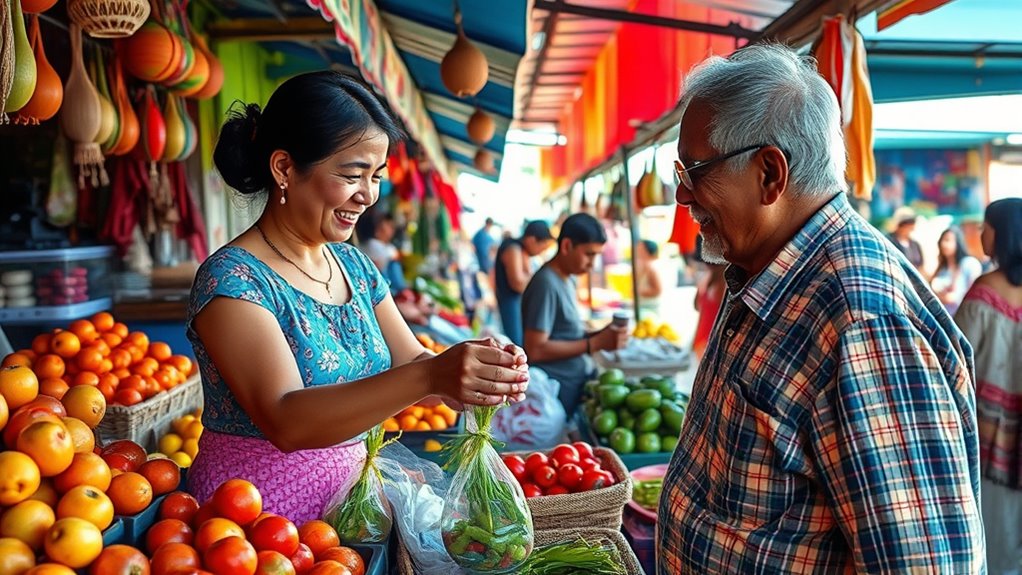
In Filipino culture, non-verbal communication plays an essential role in social interactions, shaping how relationships are formed and maintained. You’ll notice that body language, like smiles and nods, often conveys agreement and approval.
Physical contact, such as walking hand in hand, signifies affection among friends and family. Being attuned to these non-verbal cues is vital for building rapport and understanding emotions. For instance, a raised eyebrow might indicate curiosity, while avoiding eye contact could suggest discomfort.
This awareness not only fosters harmony in personal relationships but also in business settings, where non-verbal signals help maintain peace and avoid conflict. Ultimately, your ability to interpret these cues enhances your emotional intelligence and strengthens connections within your community.
Aspirational Purchasing and Economic Growth

As consumers pursue their aspirations, aspirational purchasing has become a significant driver of economic growth in the Philippines. You’re increasingly drawn to premium products that reflect your personal values and self-expression, even amid economic challenges.
With rising disposable incomes, you and others in the growing middle and upper classes are spending more on luxury items like electronics. Marketing strategies that focus on aspirations tap into your desire for self-improvement and status.
Health-conscious spending is also on the rise, as you seek healthier alternatives. Enhanced distribution networks and the Retail Trade Liberalization Act have made premium goods more accessible, further fueling your aspirations and contributing to a robust retail environment that supports overall economic growth.
Frequently Asked Questions
How Do Filipino Markets Support Local Farmers and Producers?
Filipino markets support local farmers and producers by providing direct sales platforms that cut out intermediaries, allowing them to earn more.
You can find fresh produce at events like Fresh Market, which showcase local goods. By buying from these markets, you help strengthen rural incomes and promote sustainable practices.
These spaces not only celebrate local agriculture but also foster community engagement, making it easier for you to connect with farmers and understand their contributions.
What Role Do Children Play in Family Market Visits?
When you think of bustling markets filled with vibrant colors, consider the children weaving through the crowds. Their laughter contrasts with the serious transactions happening around them.
In family visits, kids play a pivotal role; they absorb social norms, learn about money, and enjoy shared experiences. By engaging with vendors and tasting local foods, they strengthen family bonds while fostering independence and cultural appreciation, making each market trip a memorable adventure.
How Are Market Events Promoted Within Local Communities?
Market events are promoted within local communities through a mix of word-of-mouth, social media, and engaging community activities.
You’ll notice flyers, posts, and hashtags that capture attention, drawing more visitors. Local artisans and vendors participate, showcasing their products while cultural performances and food festivals add excitement.
What Types of Traditional Crafts Are Sold in Filipino Markets?
Imagine strolling through a vibrant market, where the smell of fresh produce mingles with the artistry of local crafts.
You’ll find exquisite textiles and weaving, like Inabel and T’nalak, each telling a story. Wood carvings from the Ifugao and bamboo products showcase sustainable craftsmanship.
Pottery from Vigan reflects regional beauty, while intricate beadwork and decorative items captivate the eye.
Every stall offers a glimpse into the rich cultural heritage that defines Filipino markets.
How Do Seasonal Changes Affect Market Offerings and Experiences?
Seasonal changes can really affect market offerings and experiences. You’ll notice that during holidays, certain products become in high demand, leading to a wider variety available. This means businesses adjust their stock to meet your needs.
Additionally, events tied to the season create vibrant atmospheres, making shopping more enjoyable. Special sales and themed decorations draw you in, enhancing your overall experience and encouraging you to engage with the market more actively.
Conclusion
In Filipino markets, food isn’t just sustenance; it’s a way to connect. Did you know that 83% of Filipinos say sharing meals strengthens relationships? This bond is woven through community events and cultural traditions, where every purchase tells a story. As you navigate the vibrant stalls, you’re not just buying ingredients; you’re participating in a rich tapestry of family values and love. So, next time you visit a market, embrace the moments that bring you closer to your community.









